|
The Art of the Reel
by Bob Brooke
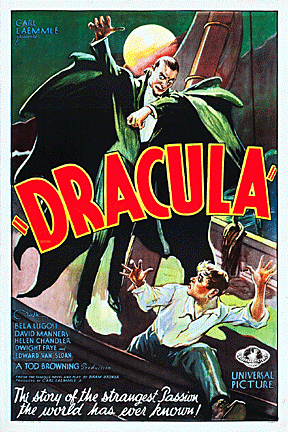 Anyone
who has gone to the movies remembers the posters of the current feature
mounted in glass cases out in front of the theater and inside the
entrance. These posters drew viewers in and each presented an image of
the film that was meant to entice and engage. Anyone
who has gone to the movies remembers the posters of the current feature
mounted in glass cases out in front of the theater and inside the
entrance. These posters drew viewers in and each presented an image of
the film that was meant to entice and engage.
In the grand old movie days of the I930s, the movies were an escape from
the harsh realties of life after the Great Depression. The usual press
run of one-sheets was about 12,000 copies for a feature film, fewer for
a "B" picture. There was an even smaller press run of "six-sheets."
Collectors prize these huge, billboard-sized versions which can bring
upwards of $20,000!
What Exactly is a Movie Poster?
Some collectors consider movie posters to be the "pop art" of the 20th
century. Some of the most desirable ones often show up matted and framed
at trendy galleries and antiques stores.
Collectors use the word "movie poster" to describe a wide variety of
types and styles of advertising paper products that movie studios use to
promote their films. All of these paper items fall into the category of
"movie art" which includes movie posters, card items, press and
promotional items.
Some collectors favor a particular genre—perhaps westerns or musicals.
Others seek sports-related posters or posters portraying a favorite
star, such as Marilyn Monroe. Currently, the most expensive examples
seem to be from what's considered the "Golden Age" of the 1930s and
1940s, with films like Gone With The Wind, The Wizard of Oz and
Casablanca.
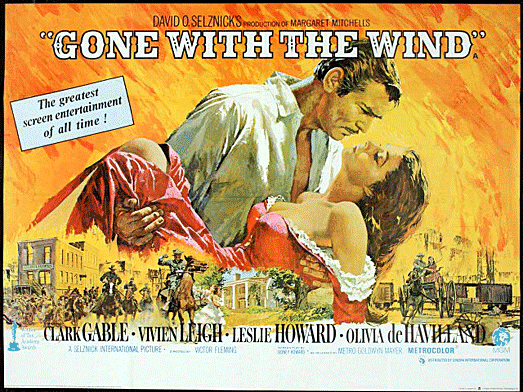
The most difficult to find are the film cards from silent films, but
they do exist. People saved them because they were attractive enough to
display in their homes.
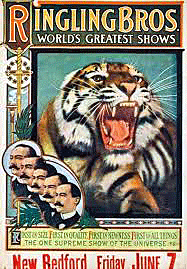 Generally,
the same companies that produced movie posters also printed circus
posters. The Morgan Litho Company of Cleveland, the printer of choice
for Ringling Brothers Circus, began in 1910 printing posters for major
film studios. Another Cleveland printing firm, Continental Lithograph
Corporation, soon picked up some studio accounts, as did Tooker Litho of
New York. Generally,
the same companies that produced movie posters also printed circus
posters. The Morgan Litho Company of Cleveland, the printer of choice
for Ringling Brothers Circus, began in 1910 printing posters for major
film studios. Another Cleveland printing firm, Continental Lithograph
Corporation, soon picked up some studio accounts, as did Tooker Litho of
New York.
Every so often a collector comes across what appears to be two slightly
altered versions of the same poster. These were known as "A" and "B"
posters. The differences had to do with where they were to be displayed.
For instance, there's a Greta Garbo poster advertising her 1927 silent
sizzler, Flesh and the Devil. One poster, designed for use in the
liberal Northeast, showed a beautiful Garbo in the arms of her lover.The
"B" poster, made for the Southern Bible Belt showed a different Garbo,
still beautiful of course, but looking repentant about all that sinning!
Vintage Posters
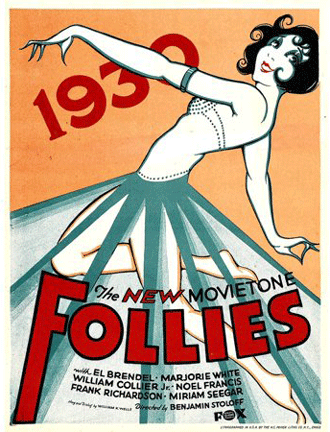 True
collectors are always on the hunt for vintage posters. Vintage movie
posters are highly collectible, especially those for films released
before the 1940s. A smaller variant of the poster, the lobby or window
card, is more widely available because theaters were allowed to add
their names to the cards and keep them. Beginning in the 1940s, theaters
were able to buy additional copies of the larger sized posters, known as
one-sheets, and keep those, too. These later posters are generally
marked with the year and edition number. True
collectors are always on the hunt for vintage posters. Vintage movie
posters are highly collectible, especially those for films released
before the 1940s. A smaller variant of the poster, the lobby or window
card, is more widely available because theaters were allowed to add
their names to the cards and keep them. Beginning in the 1940s, theaters
were able to buy additional copies of the larger sized posters, known as
one-sheets, and keep those, too. These later posters are generally
marked with the year and edition number.
Movie posters were originally produced purely as advertising, so even
the major studios rarely saved posters from their films. Thus, movie
posters from the 1920s or earlier are almost nonexistent today.
It wasn’t until the release of Star Wars in 1977 that a strong interest
in owning original movie posters became widespread. The movie posters
most sought by collectors tend to be from science-fiction films,
followed closely by those from horror flicks. Sci-fi posters from the
1950s, such as The Day the Earth Stood Still and The War of the Worlds,
are high on collectors’ wish lists.
 The
most popular era for horror posters from classic films like Dracula and
Frankenstein, tends to be the 1930s. Posters for genre movies such as
film noir, independent films, and B-movies are also desirable. In some
cases, these posters are more collectible than ones with star-studded
casts because the artwork often takes center stage. But there are
exceptions to every rule—the original 1941 Bill Gold poster for
Casablanca isn’t only graphically compelling, it features Humphrey
Bogart and Ingrid Bergman at its center. The
most popular era for horror posters from classic films like Dracula and
Frankenstein, tends to be the 1930s. Posters for genre movies such as
film noir, independent films, and B-movies are also desirable. In some
cases, these posters are more collectible than ones with star-studded
casts because the artwork often takes center stage. But there are
exceptions to every rule—the original 1941 Bill Gold poster for
Casablanca isn’t only graphically compelling, it features Humphrey
Bogart and Ingrid Bergman at its center.
Other categories of vintage movie posters include musicals, such as An
American in Paris and Singin’ In the Rain. There’s also Bollywood, with
films like Pyaasa and Shree 420, and the Beatles, with A Hard Day’s
Night and Yellow Submarine. And don’t forget James Bond, with
blockbusters like Goldfinger and Dr. No, and French New Wave, with
Breathless and Jules et Jim.
But for those just beginning their collections, posters from recent
films would make the nucleus of an interesting collection. Possibilities
might include Batman, Castaway and Top Gun.
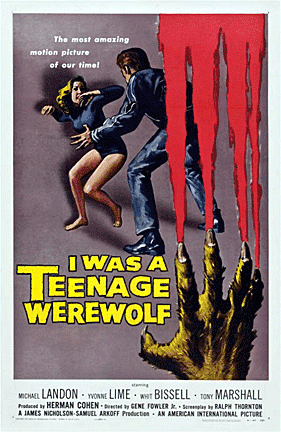 Some
collectors prize the bright, almost garish posters of the 1950s
teen-monster flicks. Weird art work of I Was A Teenage Werewolf are
increasing in value. Space related posters like Star Wars, Star Trek,
and Close Encounters of the Third Kind are also growing in value. Of
course, there’s always Elvis. Some
collectors prize the bright, almost garish posters of the 1950s
teen-monster flicks. Weird art work of I Was A Teenage Werewolf are
increasing in value. Space related posters like Star Wars, Star Trek,
and Close Encounters of the Third Kind are also growing in value. Of
course, there’s always Elvis.
Unfortunately, the biggest money-making movies don't always inspire the
most collectible posters. The best advice about collecting movie posters
is the same as the advice about any collectible. Beginning collectors
should buy what they like.
Unlike other items now sought by collectors, the movie studios never
meant for their posters and lobby cards to be in the hands of the
public. They printed them strictly for publicity purposes, then
discarded after the film had finished its run at a given theater.
Hollywood studios and film distributors encouraged theater owners to buy
a variety of posters and related publicity for displays to catch the
eyes of passers-by. Before the 1940s, theater owners almost always
purchased, then trashed these items.
 Beginning
in the early 1940s, studios began using a consolidated printing and
distribution method, the National Screen Service (N.S.S.), to handle
their posters. Theater owners began to buy publicity goods and return
them for credit. This allowed National Screen Service to use and re-use
posters, rather than print new ones. Regional warehouses were set to
handle the logistics. This change allowed posters to survive in greater
numbers because they were of some possible value down the road to the
N.S.S. Beginning
in the early 1940s, studios began using a consolidated printing and
distribution method, the National Screen Service (N.S.S.), to handle
their posters. Theater owners began to buy publicity goods and return
them for credit. This allowed National Screen Service to use and re-use
posters, rather than print new ones. Regional warehouses were set to
handle the logistics. This change allowed posters to survive in greater
numbers because they were of some possible value down the road to the
N.S.S.
Very few people collected movie posters before the nostalgia boom of the
1960s. Early collectors found it difficult to obtain posters, as a
network hadn’t yet developed to connect buyers with sellers. In
Hollywood and New York there were specialty shops where early collectors
might discover some, and at least three poster exchanges sold off their
unwanted back inventory. Naturally, as posters became a commodity sought
by the collectors, clusters of collectors gathered in certain areas.
Texas and Oklahoma, Portland and Memphis became small hotbeds of early
collectors.
After fifty years of exhaustive searches for hidden poster treasure
troves, most people would think that every available title would have
surfaced. Because of scarcity, there’s always something new to discover.
Collecting Basics
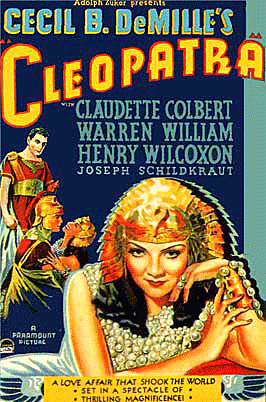 There
are no set rules when it comes to deciding what posters to collect. Many
people only purchase motion picture art by format, such as lobby cards.
Others opt to collect based on the country of origin, for example, all
Italian posters. Still others prefer to collect only within a particular
genre or certain preferred film titles. The combinations are limitless. There
are no set rules when it comes to deciding what posters to collect. Many
people only purchase motion picture art by format, such as lobby cards.
Others opt to collect based on the country of origin, for example, all
Italian posters. Still others prefer to collect only within a particular
genre or certain preferred film titles. The combinations are limitless.
Different dealers have different definitions of grading condition. It’s
wise for a beginning collector to know what’s meant by "good condition."
And to always ask about tears, stains, scratches, pin or staple holes,
fading or any retouches or repairs. While mounting a poster on
linen-backing is a perfectly acceptable archival process, it can also be
used to hide severe condition problems. When purchasing a linen-mounted
poster, the collector should ask about the condition of the poster
before it was linen-backed and how much restoration has been done to it.
Another concern is how a poster will be packed and shipped. While a
poster may leave a shop in good condition, it may arrive in worse
condition due to negligent packing. The best method is to for the shop
owner to use reinforced poster tubes, wrapping the posters in brown
Kraft paper or plastic. For flat items, he or she should use a couple of
thick pieces of cardboard, cut slightly larger than the item itself, and
packing tape around the edges.
Re-issue vs. Reproduction
 What’s
the difference between a reissue and a reproduction of a poster? Many
movies, like the Wizard of Oz, appeared in theaters subsequent to their
original dates. Though it originally played in theaters in 1939, it was
re-released in 1949, 1951, 1955, etc. The studio produced ad campaigns
for all of these releases. Studios designated all the posters and lobby
cards for these re-releases as "re-issues." Often, the artwork is
completely different, but interesting and valuable in its own right. A
reproduction, however, is simply a photographic copy of an original
poster and has little or no value as a collectible. What’s
the difference between a reissue and a reproduction of a poster? Many
movies, like the Wizard of Oz, appeared in theaters subsequent to their
original dates. Though it originally played in theaters in 1939, it was
re-released in 1949, 1951, 1955, etc. The studio produced ad campaigns
for all of these releases. Studios designated all the posters and lobby
cards for these re-releases as "re-issues." Often, the artwork is
completely different, but interesting and valuable in its own right. A
reproduction, however, is simply a photographic copy of an original
poster and has little or no value as a collectible.
How can you tell if a poster is a reproduction? There are several ways.
For instance, all 1- sheets posters before 1980 were folded, with very
rare exception. A rolled, original poster of Gone with the Wind is
simply nonexistent. Making sure the fine print is in focus is another
indication of originality.
Novice collectors can make costly mistakes if they’re not fully
informed. many of the "original movie posters" that are being sold
today, particularly through online auctions, don’t meet the strict
criteria used by collectors to label a poster as "legitimate collectible
movie art."
< Back
to Collectibles Archives
Next Article > |
